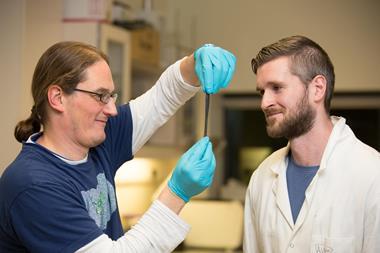Compound can detect trace amounts of water by forming fluorescent aggregates
A ‘glue’ that glows in contact with water by forming fluorescent cross-linked aggregates – in a mechanism similar to that in multi-component adhesives – has been used by researchers in China to detect water in solvents.
Sensing trace water in organic solvents is important for lab research and industrial processes, as many reactions stop working in the presence of water. The current standard method to detect water, the Karl Fischer titration, has a high sensitivity and wide detection range (0.001-100% water) but it can be expensive and time consuming.

Yongqian Xu and coworkers from the Northwest A&F University in Xianyang, China, synthesised a small organic molecule, 2,5-bis-(methoxy)benzene-1,4-dialdehyde (DMTA), which can sense trace water in organic solvents such as tetrahydrofuran (THF) or methanol.
DMTA shows a strong linear fluorescent response to 0-90% water in THF because of its high solubility and the way its two aldehyde groups interact with water molecules through intermolecular hydrogen-bonding to form cross-linked networks. This aggregation then causes fluorescence emission, visible by naked eye under a UV lamp.
The scientists can also coat DMTA onto paper by simply dipping filter paper into a DMTA solution and then drying it. This DMTA paper can then be used in bio-sensing applications, for example imaging fingerprints from sweat secreted from the fingers’ pores.
References
This article is free to access until 4 January 2017
D Wang et al, J. Mater. Chem. C, 2016, DOI: 10.1039/C6TC04238D












No comments yet